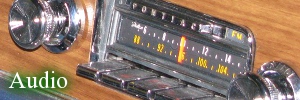















Despite Gas Prices Americans Still Taking Summer Road Trips |
|---|

|
Andrew Baroch
Voice of America
Washington, D.C.
July 26, 2006
Audio Version 1,376KB mp3
Audio Version 913KB RealPlayer
Surveys show that half of all Americans still prefer the car for summertime vacation travel -- instead of a plane, bus, or train -- despite rising gasoline prices. There appears to be a resurgent nostalgia for the great American road trip, a motorized odyssey that's long been part of the popular culture.
In a new book titled Cross Country, author Robert Sullivan describes a true-life summer adventure, traveling roundtrip by car, coast to coast on the interstate highways of the United States. The 43-year old author says he's taken the approximately 13,000 kilometer, one-month journey at least 30 times before, and each, as he puts it, has been an emotional experience "because, when you cross it, you don't realize how big it is -- if you've never done it before especially. Even after you've done it a million times, you can't believe how big the country is. The Great Plains -- you can feel the vastness of them. Then you're up in the Rockies, and you can't believe that one country can hold both places at the same time."
The book is likely to strike a chord with many Americans who hanker to hit the road and see their big country for themselves. The U.S. Department of Energy says taken together, Americans will drive a total of about 1300 billion kilometers this summer for vacation travel, or nearly 14 billion kilometers a day. Most public opinion surveys show that while many Americans are complaining about the climbing price of gasoline - for this travel season anyway - they've decided to hit the road again.
In his book, Sullivan, recounts familiar car travel experiences. The author, his wife and two children are cooped up in the family automobile for days on end -- sharing stories, singing songs, and dealing with the boredom.
"You end up spending six or seven hours [a day] just sitting in the car, eating nuts or cheese and crackers and apples -- and you move. You move, you move, you move."
While the odyssey as a literary theme is centuries' old, Sullivan notes that what comes to mind for many Americans on a long road trip is the 1950's literary classic, On the Road, written by the restless, free-thinking Jack Kerouac. Sullivan says that when he's on the road, he's searching for the kind of insights Kerouac wrote about.
"He was definitely a 'road mystic.' I think that's kind of what the driving cross-country experience does for all of us. It gives us a shot at being a 'mystic for a minute.' It just means not necessarily thinking of yourself for a minute, or your own place. It means thinking about somebody else or somebody else's place and it means, for a minute, thinking, 'what would it be like to be [living] here, and be in these people's shoes."
Sullivan's other heroes are early 19th century American explorers Lewis and Clark, who were the first to survey the middle and western portions of the continent for future expansion.
"Historically, the United States has always been about 'going west.' We always talked about westward expansion, marching west to the setting sun. And there's a long history in America of trying to 'see America,'" Sullivan says. "In the 1860's and seventies, there were groups of people who started saying 'you've got see America to be a real American citizen.' We've had this long tradition of trying to 'see America.' Of course, this year is a very exciting year for me because it's the anniversary of the interstate highway system."
The 50th anniversary, to be precise, of the start of construction of what has become a 75,000-kilometer network of interstate highways crisscrossing the United States. The largest public works project in history, the interstate's broad, multi-lane highways replaced narrow, dirt roads, making most of the country accessible to Americans who can only afford to travel by car.
For those who can't do a road trip this summer, the National Museum of American History in Washington, D.C., offers what may be the next best thing -- an exhibit titled America on the Move. Washington actress Hilary Kacser plays a role in the exhibit, "a living history character," she says. "Flossie Haggard. Flossie and her family -- like so many -- migrated from Oklahoma to California [during the economic Depression of the 1930's] on Route 66 and had all kinds of opportunities -- economic, social, cultural -- because of what the road did. It gave regular folks a chance to come and go as they wanted. She [Flossie] says, 'We were like a new community of automobile travelers -- Flossie Haggard and her family -- on the road.' She said that 'traveling like that gave you the opportunity to meet people you'd never run into in your hometown.'"
The lure of the automobile road trip, nearly a century old in the United States, remains a powerful current in American culture.
